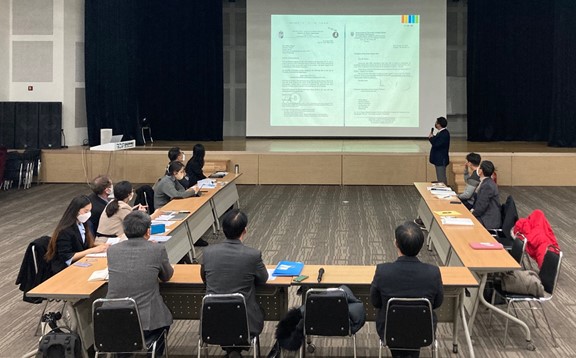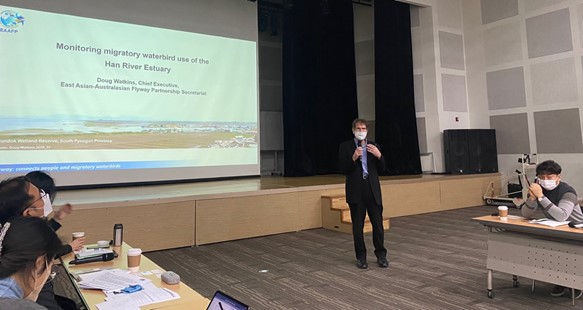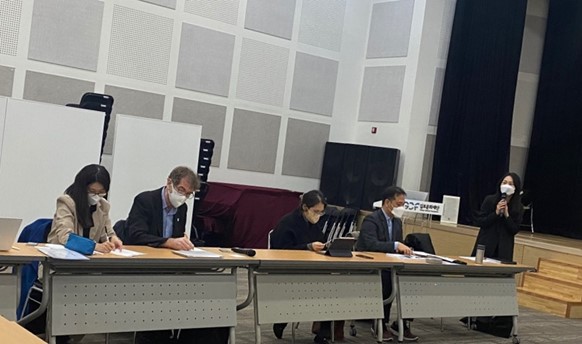On 2nd December 2021, Hanns Seidel Foundation Korea (HSF Korea) hosted a roundtable meeting “ Conservation of Migratory birds and their habitats along the Han River Estuary” for discussing the importance of Han River Estuary in Ro Korea and practical ways of inter-Korean cooperation with international organizations. The participants of the meeting were from the Ramsar Regional Center – East Asia (RRC-EA), PGA Eco & Bio Diversity Institute, Government of Gimpo City, the Incheon Institute, Goyang Research Institute, DMZ Ecological Research Institute, and EAAFP Secretariat.

Conservation of migratory birds and their habitats along with the Han River Estuary Roundtable Meeting © EAAFP Secretariat
Han River Estuary (HRE) including Flyway Network Site EAAF028 is internationally important for waterbirds during the migratory seasons, designated as a Wetland Protected Area in 2006 by the Ministry of Environment in RO Korea. Han River Estuary wetlands include Goyang, Janghang wetland, Gimpo Siamri wetland, and Paju Sannam wetlands. On 21 May 2021, only Goyang Janhang Wetland was designated as a Ramsar Site. In addition, HRE is a neutral area between North and South Korea and conducted a joint survey on the waterway in terms of the military in 2018 for the first time since 1953, Korea War Armistice Agreement was signed. There is no ecological and bird survey between the two Koreas yet.

Mr. Doug Watkins, Chief Executive of the EAAFP Secretariat, giving a presentation ⓒ Hyoeun Kim/EAAFP Secretariat
The roundtable meeting discussed Han River Estuary’s importance, and potential approaches of inter-Korean Cooperation with international organizations such as EAAFP, RRC-EA, HSF Korea, to enhance conserving habitats by utilizing international/ national networking.

Dr. Hyun–Ah Choi, Senior Researcher of Hanns Seidel Foundation, giving a speech ⓒ Hyoeun Kim, EAAFP Secretariat
Mr. Seungoh Suh, Executive Director of RRC-EA, delivered the guidelines for international cooperation and transboundary Ramsar Site registration under the Ramsar Convention for Han River Estuary as Transboundary Ramsar site by Ro Korea and DPR Korea. The case with Hungary and Slovakia shows the desirable community building example for a transboundary Ramsar Site. He also highlighted that the most crucial element in the Ramsar Convention is continuous management.
Following the presentation, Mr. Doug Watkins, Chief Executive of the EAAFP Secretariat, conveyed how to enhance conservation on wildlife habitats through international cooperation. He introduced the international frameworks such as Natural World Heritage and potential approaches to building capacities of DPRK for waterbird conservation.
Dr. Donguk Han, General Director of PGA Eco&Bio Diversity Institute, highlighted that the history of Janghang Wetland and Han River Estuary. The presentation suggested to register the other wetlands in HRE as Ramsar Sites before moving forward to the next step.
Mr. Seungho Kim, He acknowledged that some citizens are unaware of an internationally important wetland’s actual value and benefits.
Dr. Hyun- Ah Choi, Senior Researcher of HSF Korea, conveyed the insight of DPRK conservation works for wetland and the meaning of roundtable meeting.

Group photo of the Roundtable meeting © EAAFP Secretariat
An open discussion followed the presentation session brought up the points on:
– Identifying where to conserve for a transboundary conservation site between RO and DPR Korea
– Local governments’ involvement to boost progressive and sustainable conservation with the inter-Korean cooperation
– Listening to the younger generation is crucial for continuous conservation




